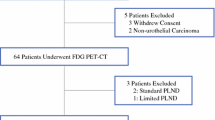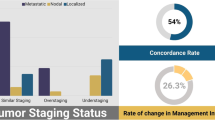Abstract
Objectives
Preoperative 18F-fluoro-2-deoxy-d-glucose (18F-FDG) positron emission tomography/computed tomography (PET/CT) is controversial to assess lymph node (LN) staging in patients with invasive bladder cancer. We proposed to use the maximum standardized uptake value (SUVmax) associated with axial-based LN size to improve the detection of regional LN metastasis.
Methods
From May 2015 to May 2017, we prospectively included patients with urothelial bladder cancer who underwent radical cystectomy with extended pelvic LN dissection. All patients underwent preoperative 18F-FDG PET/CT staging before surgery. The gold standard comparator was the pathological examination of resected LNs. The data were reported on a regional per area- and patient-based model according to SUVmax values and axial-based LN size criteria.
Results
In total, 1012 LNs were identified in 61 patients with clinically localized invasive bladder cancer who underwent radical cystectomy and extended pelvic LN dissection. Loco-regional involvement of 24 LN areas was confirmed in 17 patients. In per area analysis, diagnostic accuracy of PET/CT and CT alone were respectively 84% and 78% (p = 0.039). On patient-based analysis, combined PET/CT correctly classified pelvic LN status in 5/61 (+ 8%) additional patients using optimal thresholds compared to CT alone, with accuracies of 82% and 74%, respectively (p = 0.13).
Conclusion
Combining SUVmax and axial-based LN size criteria using 18F-FDG PET/CT improved the diagnostic accuracy for preoperative LN staging in patients with invasive bladder cancer, in per area analysis.
Key Points
• Combining metabolical and morphological features using18F-FDG PET/CT improves the detection of malignant lymph node in patients with bladder cancer.
• 18 F-FDG PET/CT may help for initial staging of patients with muscle invasive bladder cancer.


Similar content being viewed by others
Abbreviations
- ePLND:
-
Extended pelvic lymph node dissection
- IQR:
-
Interquartile range
- LN:
-
Lymph node
- MIBC:
-
Muscle-invasive bladder cancer
- NAC:
-
Neoadjuvant chemotherapy
- NMIBC:
-
Non-muscle-invasive bladder cancer
- PPV:
-
Positive predictive value
- NPV:
-
Negative predictive value
- RC:
-
Radical cystectomy
- SUVmax :
-
Maximal standardized uptake value
References
Torre LA, Bray F, Siegel RL, Ferlay J, Lortet-Tieulent J, Jemal A (2015) Global cancer statistics, 2012. CA Cancer J Clin 65:87–108
Sanli O, Dobruch J, Knowles MA et al (2017) Bladder cancer. Nat Rev Dis Primers 3:17022
Antoni S, Ferlay J, Soerjomataram I, Znaor A, Jemal A, Bray F (2017) Bladder cancer incidence and mortality: a global overview and recent trends. Eur Urol 71(1):96–108
Kamat AM, Hahn NM, Efstathiou JA et al (2016) Bladder cancer. Lancet 388(10061):2796–2810
Hautmann RE, de Petriconi RC, Pfeiffer C, Volkmer BG (2012) Radical cystectomy for urothelial carcinoma of the bladder without neoadjuvant or adjuvant therapy: long-term results in 1100 patients. Eur Urol 61(5):1039–1047
Apolo AB, Riches J, Schöder H et al (2010) Clinical value of fluorine-18 2-fluoro-2-deoxy-D-glucose positron emission tomography/computed tomography in bladder cancer. J Clin Oncol 28(25):3973–3978
Mertens LS, Fioole-Bruining A, Vegt E, Vogel WV, van Rhijn BW, Horenblas S (2013) Impact of (18) F-fluorodeoxyglucose (FDG)-positron-emission tomography/computed tomography (PET/CT) on management of patients with carcinoma invading bladder muscle. BJU Int 112(6):729–734
Yang Z, Cheng J, Pan L et al (2012) Is whole-body fluorine-18 fluorodeoxyglucose PET/CT plus additional pelvic images (oral hydration-voiding-refilling) useful for detecting recurrent bladder cancer? Ann Nucl Med 26(7):571–577
Alfred Witjes J, Lebret T, Compérat EM et al (2017) Updated 2016 EAU guidelines on muscle-invasive and metastatic bladder cancer. Eur Urol 71(3):462–475
Pichler R, De Zordo T, Fritz J et al (2017) Pelvic lymph node staging by combined18F-FDG-PET/CT imaging in bladder cancer prior to radical cystectomy. Clin Genitourin Cancer 15(3):e387–e395
Hitier-Berthault M, Ansquer C, Branchereau J et al (2013) 18 F-fluorodeoxyglucose positron emission tomography-computed tomography for preoperative lymph node staging in patients undergoing radical cystectomy for bladder cancer: a prospective study. Int J Urol 20(8):788–796
Goodfellow H, Viney Z, Hughes P et al (2014) Role of fluorodeoxyglucose positron emission tomography (FDG PET)-computed tomography (CT) in the staging of bladder cancer. BJU Int 114(3):389–395
Rouanne M, Girma A, Neuzillet Y et al (2014) Potential impact of 18F-FDG PET/CT on patients selection for neoadjuvant chemotherapy before radical cystectomy. Eur J Surg Oncol 40(12):1724–1730
Jeong IG, Hong S, You D, Hong JH, Ahn H, Kim CS (2015) FDG PET-CT for lymph node staging of bladder cancer: a prospective study of patients with extended pelvic lymphadenectomy. Ann Surg Oncol 22(9):3150–3156
Swinnen G, Maes A, Pottel H et al (2010) FDG-PET/CT for the preoperative lymph node staging of invasive bladder cancer. Eur Urol 57(4):641–647
Kibel AS, Dehdashti F, Katz MD et al (2009) Prospective study of [18F] fluorodeoxyglucose positron emission tomography/computed tomography for staging of muscle-invasive bladder carcinoma. J Clin Oncol 27(26):4314–4320
Uttam M, Pravin N, Anish B, Nandita K, Arup M (2016) Is [F-18]-fluorodeoxyglucose FDG-PET/CT better than ct alone for the preoperative lymph node staging of muscle invasive bladder cancer? Int Braz J Urol 42(2):234–241
Aljabery F, Lindblom G, Skoog S et al (2015) PET/CT versus conventional CT for detection of lymph node metastases in patients with locally advanced bladder cancer. BMC Urol 15:87
Soubra A, Hayward D, Dahm P et al (2016) The diagnostic accuracy of 18F-fluorodeoxyglucose positron emission tomography and computed tomography in staging bladder cancer: a single-institution study and a systematic review with meta-analysis. World J Urol 34(9):1229–1237
Vind-Kezunovic S, Bouchelouche K, Ipsen P, Høyer S, Bell C, Bjerggaard Jensen J (2017) Detection of lymph node metastasis in patients with bladder cancer using maximum standardised uptake value and18F-fluorodeoxyglucose positron emission tomography/computed tomography: results from a high-volume centre including long-term follow-up. Eur Urol Focus. https://doi.org/10.1016/j.euf.2017.06.005
ADASP Committee. The Association of Directors of Anatomic and Surgical Pathology (2001) ADASP recommendations for processing and reporting of lymph node specimens submitted for evaluation of metastatic disease. Mod Pathol 14(6):629–632
Société Française de Médecine Nucléaire et d’Imagerie Moléculaire (2018) Recommandations de bonne pratique clinique pour l’utilisation de la TEP en cancérologie. Available via https://www.sfmn.org/drive/SFMN/GUIDES%20DE%20PROCEDURES/GuidesEtRecommandation_PublicWeb/RBP%20utilisation%20TEP%20en%20cancerologie%20thesaurus_V1.pdf. Accessed May 2018
Nguyen HT, Shah ZK, Mortazavi A et al (2017) Non-invasive quantification of tumour heterogeneity in water diffusivity to differentiate malignant from benign tissues of urinary bladder: a phase I study. Eur Radiol 27(5):2146–2152
Lee M, Shin SJ, Oh YT et al (2017) Non-contrast magnetic resonance imaging for bladder cancer: fused high b value diffusion-weighted imaging and T2-weighted imaging helps evaluate depth of invasion. Eur Radiol 27(9):3752–3758
Panebianco V, De Berardinis E, Barchetti G et al (2017) An evaluation of morphological and functional multi-parametric MRI sequences in classifying non-muscle and muscle invasive bladder cancer. Eur Radiol 27(9):3759–3766
Derlin T, Weiberg D, von Klot C et al (2016) 68Ga-PSMA I&T PET/CT for assessment of prostate cancer: evaluation of image quality after forced diuresis and delayed imaging. Eur Radiol 26:4345–4353
Davarpanah NN, Yuno A, Trepel JB, Apolo AB (2017) Immunotherapy: a new treatment paradigm in bladder cancer. Curr Opin Oncol. https://doi.org/10.1097/CCO.0000000000000366
Rijnders M, de Wit R, Boormans JL, Lolkema MPJ, van der Veldt AAM (2017) Systematic review of immune checkpoint inhibition in urological cancers. Eur Urol 72(3):411–423
Funding
The authors state that this work has not received any funding.
Author information
Authors and Affiliations
Corresponding author
Ethics declarations
Guarantor
The scientific guarantor of this publication is Antoine Girard.
Conflict of interest
The authors of this manuscript declare no relationships with any companies whose products or services may be related to the subject matter of the article.
Statistics and biometry
No complex statistical methods were necessary for this paper.
Informed consent
Written informed consent was obtained from all subjects (patients) in this study.
Ethical approval
Institutional Review Board approval was obtained.
Methodology
• prospective
• diagnostic study
• performed at one institution
Additional information
Publisher’s Note
Springer Nature remains neutral with regard to jurisdictional claims in published maps and institutional affiliations.
Antoine Girard and Mathieu Rouanne are first co-authors.
Rights and permissions
About this article
Cite this article
Girard, A., Rouanne, M., Taconet, S. et al. Integrated analysis of 18F-FDG PET/CT improves preoperative lymph node staging for patients with invasive bladder cancer. Eur Radiol 29, 4286–4293 (2019). https://doi.org/10.1007/s00330-018-5959-0
Received:
Revised:
Accepted:
Published:
Issue Date:
DOI: https://doi.org/10.1007/s00330-018-5959-0




